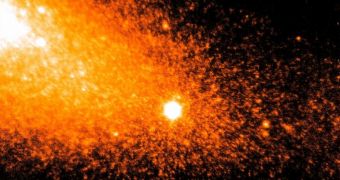A new instance of a rare cosmic event known as a Type Ia supernova was discovered around two weeks ago by Steve Fossey, a professor with the University of London Observatory, as he was hosting a demonstration for astronomy students.
The expert pointed the ULO 14-inch telescope at Messier 82 (M82), a well-known, nearby galaxy. As he did so, he noticed an extremely bright object that should have not been there. An on-the-fly study determined that the object was in fact a Type Ia supernova.
These events occur exclusively in binary star systems, or in binary systems containing a neutron star or a black hole. White dwarfs in these systems tend to accrete mass from their companions, so much so that they eventually become unstable and shed the excess material in a huge explosion.
By comparison, Type II supernovae are produced when massive stars at least 8 times heavier than the Sun reach the end of their burning cycle, and explode with a massive bang. These blasts usually obliterate the massive stars, and produce light so luminous that it briefly outshines entire galaxies.
The object Fossey discovered has since been dubbed SN2014J. It took a lot of luck for the astronomer to be looking at the correct place at the correct time, but fortunately this enabled the international community to potentially gain more insight into a phenomenon that occurs around once per century.
After Fossey alerted the international community about the findings, the teams operating the Keck I and Keck II 10-meter (33-foot) telescopes at the Keck Observatory in Hawaii decided to suspend their own studies, and point the world's largest binocular telescope at M82 and SN2014J.
“It was very exciting: this was the second nearest supernova in recent history. Usually, we know what we are going to be observing for months before we get here,” says University of Hawaii astronomer Michael Liu, who was in charge of the Keck II Telescope when it was turned towards M82.
“Keck‘s Adaptive Optics system allows you to get very sharp images of the sky, as you would from space, and allows a very precise position of the supernova. We can compare it to old images to possibly determine the progenitor system,” says California Institute of Technology post-doctoral researcher Shriharsh Tendulkar.
“While there are many supernovae explosions in the Universe, this one is important because it is close enough that with Keck’s AO, we have an excellent chance of identifying the progenitor,” concludes the head of night-time operations for W. M. Keck Observatory, Bob Goodrich.

 14 DAY TRIAL //
14 DAY TRIAL //